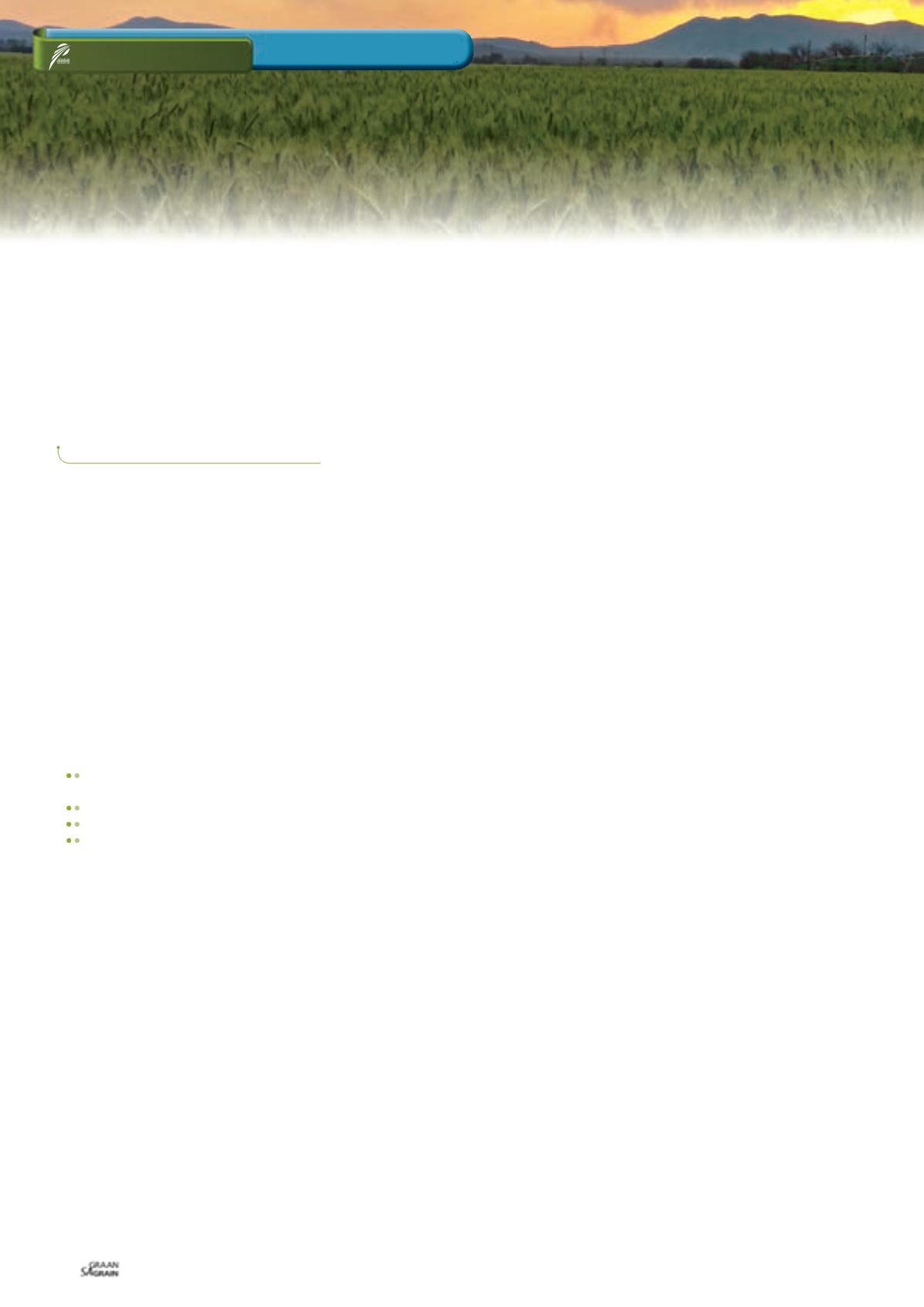

November 2016
80
New trading environment
analysed at 25th International
Grains Council Conference
S
outh Africa is one of the key players in global grain mar-
kets and its footprint is clear in international forums such
as the International Grains Council. Every year, the grain
trusts (Winter Cereal and Maize Trust) nominate individuals
to represent the industry in these international engagements.
This year, Mr Nico Hawkins (SAGIS) and Mr Wandile Sihlobo (Agbiz)
were amongst those privileged enough to attend the 25th Interna-
tional Grains Council Conference in London, UK.
The main theme of the conference was ‘Changing dynamics: The
new trading environment’ under which were contributions from
all major grain producing regions, such as the United States of
America (USA), China, Ireland, Australia, the Black Sea region and
the European Union.
Four key subjects stood out in the Conference presentations, and
these include:
The rising concern about climate change and its effects on grain
production.
The changing dynamics in the global grain supply and demand.
Agricultural policies (subsidies and price-support measures).
International trade agreements.
Rising concern about climate change and
its effects on grain production
Dr Corey Cherr, head of Agriculture and Weather Research at Lan-
worth, shared insights on climate change and its relative impact on
crops. The key risk with regards to recent climatic developments is
La Niña – particularly in the Northern Hemisphere. The crops that
are likely to be negatively affected in the 2016/2017 season are soy-
beans and maize, due to expected dryness later in the year across
the USA Midwest. Wheat production is expected to be fair in the
2016/2017 season.
The changing dynamics in the global
grain supply and demand and
agricultural policies
Mr Alan Tracy, president of US Wheat Associates, focussed on the
changing landscape of global wheat trade.
Wheat is the most traded grain in the world, with soybean and maize
interchanging over the years. With regards to production, however,
it is the second most produced crop after maize. In the 2016/2017
production year, global wheat production is forecast at 730 million
tons, with hectares set to remain fairly flat. The leading producers
are China, India, the USA, Russia, France, Canada, Germany, Paki-
stan, Australia and the Ukraine.
Additionally, the 2016/2017 wheat trade volumes could increase to
164 million ton, from 161 million tons in 2015/2016 season. USA,
Canada, France, Australia, Russia, Germany, Ukraine and Argentina
are expected to be the leading countries on the export side.
It is important to note that there have been big shifts in the recent
past in the global wheat market – a notable one being Russia’s tran-
sition from being a net importer to a global exporter. To some ex-
tent, the rise in Russia’s wheat exports has created competition for
USA wheat exporters, especially in the European, Middle East and
African markets.
In fact, over the years the USA has lost roughly 10 million tons
market size in the Middle East, North Africa and Indian market. How-
ever, the USA has somehow managed to gain market share in the
Latin and Asian markets, estimated at 22 million tons.
A noteworthy development in the recent past is the increasing de-
mand for high quality wheat throughout the world, particularly
across the Americas. This has, of course, been driven by an increas-
ing middle class and changes in consumption patterns.
Global agricultural policy also came under the spotlight because of
its significance for the wheat market. The USA Wheat Associates ar-
gue that domestic price support is the most significant market dis-
tortion today, as opposed to domestic price support measures.
In this regard, China, India, Turkey and Brazil are seen as the leading
countries with the highest domestic price support measures distort-
ing the market.
International trade agreements
There is currently an emergence of the so called ‘mega-regionals’ in
the global trade environment. Mega-regionals are trade agreements
between partners making up a significant portion of global trade,
that aim for integration beyond traditional trade concerns such as
tariffs with ambitions to oversee issues such as regulatory co-oper-
ation and investment.
The most prominent mega-regionals on the global trade scene in-
clude the Transatlantic Trade and Investment Partnership (TTIP) and
the Trans-Pacific Partnership (TPP).
Mr Masanori Hayashi of the Japanese Ministry of Agriculture, did
a presentation on the TPP. The TPP is a trade agreement amongst
RELEVANT
WANDILE SIHLOBO,
head economist: Agbiz

















